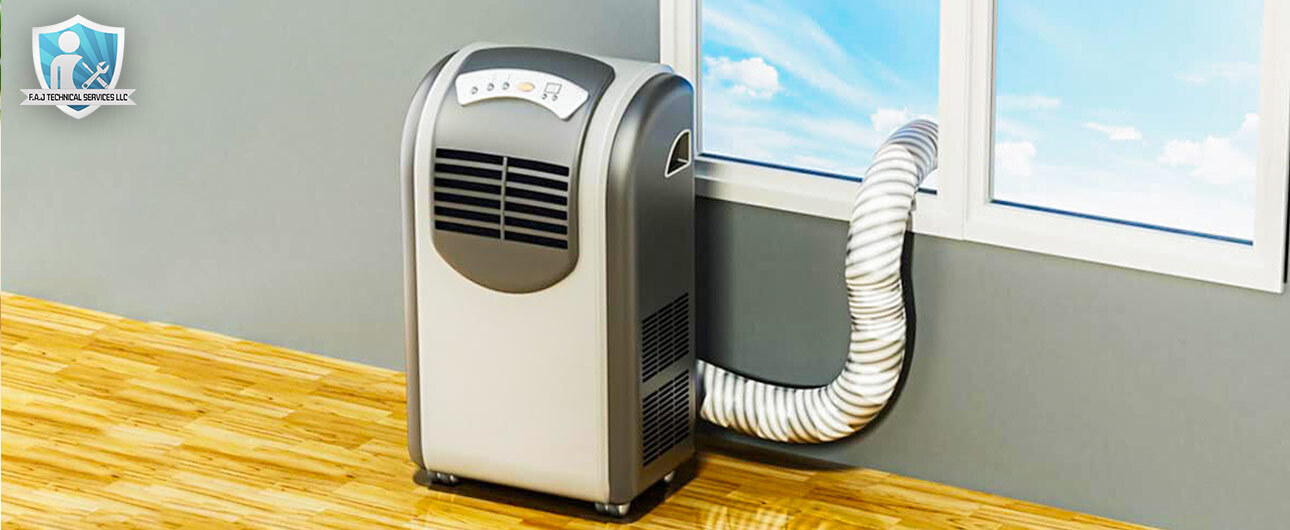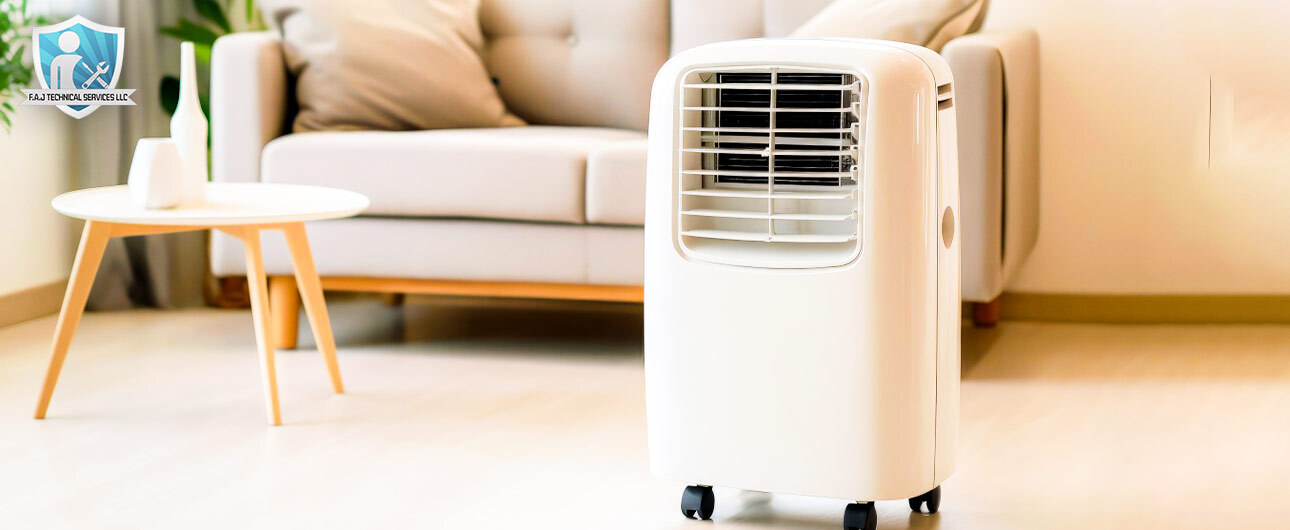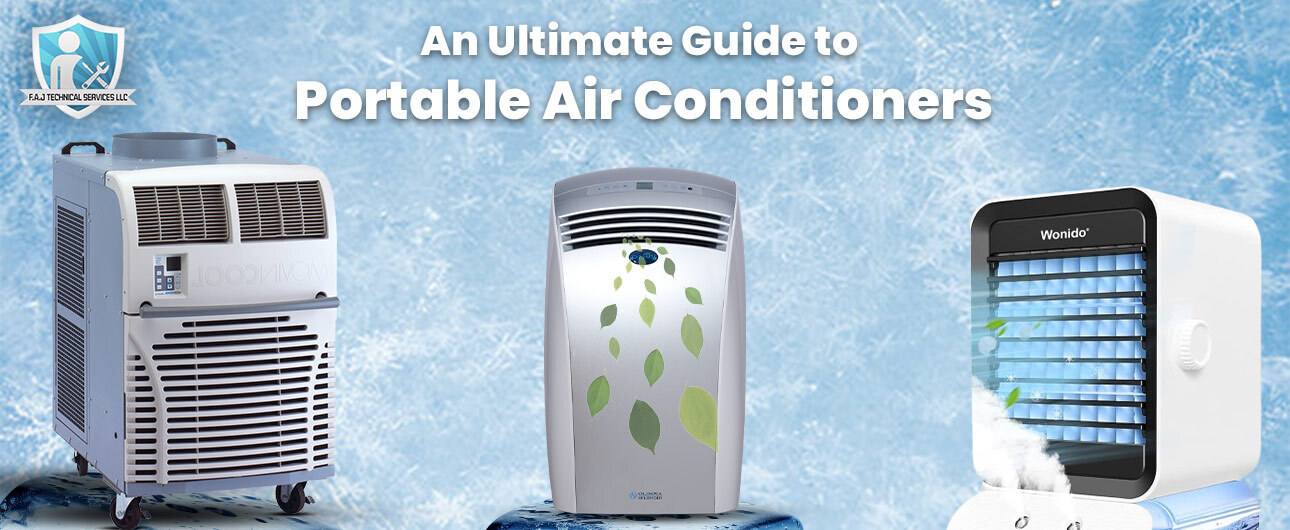Introduction
Portable air conditioners have become increasingly popular for their convenience and efficiency in cooling specific areas without the need for permanent installation.
If you're considering investing in one, this comprehensive guide will walk you through everything you need to know about portable air conditioners—from types and benefits to factors to consider before buying, applications, and tips on using it effectively.
Portable AC Types

Portable air conditioners come in different types, each serving specific purposes:
1. Single-hose vs. Dual-hose Portable Air Conditioners
Single-hose units use one hose to push out hot air and moisture while bringing in fresh air from the room to cool. They are easier to set up but might not be as efficient as dual-hose models.
Dual-hose units have separate intake and exhaust hoses. This setup prevents air pressure issues inside the room, improving how well they cool. They are great for larger spaces or places where cooling is crucial.
2. Evaporative Coolers vs. Traditional Portable Air Conditioners
Evaporative coolers cool air by using water, which makes them energy-efficient in dry climates. They operate by evaporating water and can increase humidity levels, which may not be ideal in humid areas.
Traditional portable air conditioners work like window units but stand alone and release hot air through a hose to the outside.
Applications of Portable Air Conditioners
Portable air conditioners serve a variety of purposes across different environments:
Residential Use
In residential settings, portable air conditioners are ideal for cooling specific rooms or areas where traditional air conditioning systems are impractical or costly to install.
Commercial Use
Businesses use portable air conditioners to cool server rooms, offices, and temporary workspaces. They provide flexibility and efficient cooling solutions without the need for extensive ductwork.
Benefits of Portable Air Conditioners
Portable air conditioners offer several advantages that make them a popular choice for cooling:
Easy Installation: Portable air conditioners are designed for quick and simple installation, requiring minimal effort (Energy Star, n.d.).
User-Friendly Interface: Their controls are typically intuitive and easy to use, making them accessible for all users, including children (Consumer Reports, 2023).
Low Power Consumption: Compared to traditional air conditioning systems, portable units consume less electricity, which can result in cost savings over time (Energy Star, n.d.).
Instant Cooling: They provide rapid cooling once turned on, making them effective for immediate temperature relief (Consumer Reports, 2023).
Convenient Mobility: Being portable, these units can be easily moved from room to room as needed, offering flexibility and potentially reducing the need for multiple units (Energy Star, n.d.).
Multiple Functions: Many models come equipped with advanced features, such as programmable settings and remote controls, enhancing user convenience (Consumer Reports, 2023).
Quiet Operation: Portable air conditioners are designed to operate quietly, minimizing noise disruption in indoor environments (Energy Star, n.d.).
Air Filtration: Some portable air conditioners include air filtration systems that help remove allergens and pollutants from the air, improving indoor air quality (Consumer Reports, 2023).
Cost-Effective: They are often more affordable to purchase and operate than traditional central air conditioning systems, particularly for smaller spaces (Energy Star, n.d.).
Eco-Friendly: Many portable air conditioners use eco-friendly refrigerants, contributing to lower environmental impact compared to older models (Consumer Reports, 2023).
Challenges and Limitations
While portable air conditioners offer versatility, they also come with certain limitations:
Cooling Effectiveness in Larger Spaces
Single-hose units may struggle to cool larger rooms effectively due to the continuous need to draw in warm air from outside.
Noise Levels
Some models can produce noticeable noise levels during operation, which may be disruptive in quiet environments.
Condensation and Drainage
Managing condensation and drainage can be challenging, requiring regular emptying of the unit's condensate reservoir or continuous drainage setup.
How Do Portable Air Conditioners Work?

Portable air conditioners cool the air through a refrigeration cycle:
They pull in warm air from the room through a vent.
This air passes over cold coils that contain a refrigerant (cooling fluid), which absorbs heat from the air and cools it down.
A fan inside the unit blows this cooled air back into the room.
The heat absorbed by the refrigerant is then released outside through an exhaust hose, usually through a window or vent.
Factors to Consider When Buying a Portable Air Conditioner
.jpg)
Consider these factors before purchasing a portable air conditioner, advised by the HVAC Professional at FAJ Professional.
Cooling Capacity: Decide how much cooling power you need. This depends on the size of the room you want to cool.
BTU rating: Before you buy a portable air conditioner, figure out its BTU rating. A good rule of thumb is to multiply the room's square footage by 20 to find the right BTU rating. For example, for a room that is 12 feet by 12 feet, multiply 144 square feet by 20.
Energy Efficiency: Look for a portable air conditioner that uses less energy. Check the Energy Efficiency Ratio (EER) to see how efficiently it cools. Generally, aim for units with an EER of 8.5 or higher to save money on energy bills, especially in different weather conditions.
Noise Level: Choose a unit that doesn't make too much noise. Units with a noise level below 55 decibels are quieter and better for peaceful operation.
Portability and Installation: Consider how easy it is to move the air conditioner around. Portable designs are usually easier to relocate or set up in different places.
You might also like: Learn 7 Practical Tips for Energy Efficient AC Usage
Portable AC Unit Brands and Reviews
Before making a purchase, research popular brands and read customer reviews to gauge reliability, performance, and overall satisfaction with specific models. This will help you to decide which brands are best as per your requirements.
Installation and Setup Guide

Location: Choose a spot near a window or door to vent the exhaust hose outside for efficient cooling.
Ventilation: Ensure there's enough space around the air conditioner for good airflow, avoiding cramped areas.
Electrical Connection: Plug the air conditioner into a suitable outlet without using extension cords, if possible.
Filter: Install the air filter as instructed by the manufacturer and clean or replace it regularly.
Thermostat: Use the thermostat to set your desired room temperature for energy efficiency and comfort.
Maintenance: Regularly clean the filter and check the exhaust hose for any blockages to keep the air conditioner working well.
If you are looking for a Portable AC maintenance company in Dubai, book an appointment with FAJ Technical Services LLC to get reliable and professional AC maintenance services.
Tips for Using Portable Air Conditioners Effectively
Proper Ventilation: Make sure there's a proper exhaust hose in the room for ventilation. Without good ventilation, air conditioners won't work well. Ensure the exhaust hose is in the right place.
Regular Maintenance: Portable air conditioners need to be maintained regularly. It costs a bit, but it makes the air conditioner work better.
Cleaning the Filters: Clean the filter twice a month or replace it to make it work better.
Positioning: Choosing the right spot for a portable air conditioner is important for effective cooling. Place it near a window or door where you can vent the exhaust hose outside.
Temperature Control: Use the thermostat to set how cool you want it. It saves energy and keeps the room cool.
Conclusion
Portable air conditioners offer a flexible and convenient cooling solution for homes and commercial spaces. You can beat the heat in summer by availing of the different types of air conditioners and besides this understand the supplementary requirements.
FAQs
What size portable AC do I need for my room?
Choose a unit with the appropriate BTU rating based on your room size for efficient cooling. For example, for a room that is 12 feet by 12 feet, multiply 144 square feet by 20 to get the recommended BTU rating.
Can a portable air conditioner cool a whole house?
No, portable air conditioners are designed to cool specific rooms or areas, not entire houses. They are most effective in single rooms or small apartments where they can provide localized cooling.
How to install a portable air conditioner?
Installing a portable air conditioner is easy and simple:
Position the unit near a window or an opening where you can vent the hot air outside using the provided exhaust hose.
Connect the exhaust hose securely to the unit and extend it to the window or vent.
Adjust the window kit to fit the window or opening, ensuring a tight seal to prevent hot air from entering back into the room.
Plug the unit into a grounded electrical outlet and follow the manufacturer's instructions for initial setup and operation.
Is a portable air conditioner good?
Yes, portable air conditioners have benefits like easy setup, mobility, and flexibility. They're useful for renters or homeowners who can't use traditional window units or central AC systems.
However, how well they work depends on factors like room size, insulation, and the climate where you live.
Do portable air conditioners work well?
Portable air conditioners can work well in cooling specific areas or rooms. Their performance depends on factors like the unit's BTU (British Thermal Unit) rating, room size, insulation, and ambient temperature. Proper installation and maintenance also play crucial roles in their effectiveness.
How does a portable air conditioner work?
The vent pulls all the warm air from the room, the refrigerant cools the warm air by absorbing the heat. Internal fan blows cooler air into the room to create a comfortable environment for you and your family.
Do portable air conditioners use a lot of electricity?
Portable air conditioners vary in electricity usage depending on their size and efficiency. A typical unit with 8,000 BTU consumes about 1.0-1.2 kWh per hour, while larger units around 14,000 BTU can use 1.4-1.8 kWh per hour.
For example, running an air conditioner for 8 hours a day at $0.15 per kWh costs between $1.20 and $2.16 daily. Efficient use and regular maintenance can help reduce electricity costs associated with portable air conditioners.
Can I use a portable AC in a room without windows?
Portable AC units require proper ventilation, so consider alternative venting options if windows are not available.
